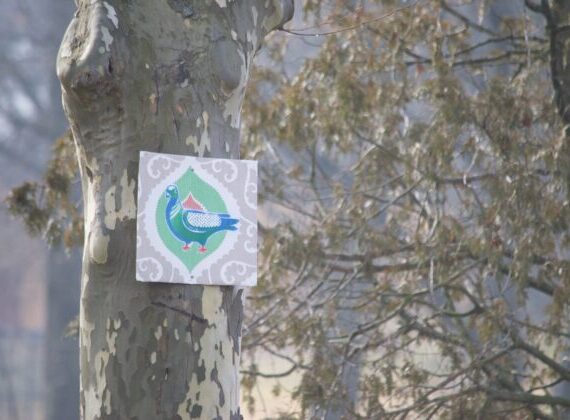
The week began with hope and anticipation. A Monday morning site meeting with an engineer and a planner from the Department of Transportation had gone remarkably well, and neighborhood representatives looked forward to seeing what new ideas the CT Fastrak team had developed for the Flower  Street crossing since the May 20th decision requiring that the crossing remain passable. Alas, this bright outlook was no match for the reality of the July 16 meeting the DOT hosted at the Lyceum in Hartford. Officials showed old drawings of overpass designs and a remarkably similar attitude toward neighborhood advocates to that of their August 2012 public meeting in the same room. Several officials, including Commissioner James P. Redeker, said they were not expecting the May decision to be in favor of the neighborhood stakeholders.
Street crossing since the May 20th decision requiring that the crossing remain passable. Alas, this bright outlook was no match for the reality of the July 16 meeting the DOT hosted at the Lyceum in Hartford. Officials showed old drawings of overpass designs and a remarkably similar attitude toward neighborhood advocates to that of their August 2012 public meeting in the same room. Several officials, including Commissioner James P. Redeker, said they were not expecting the May decision to be in favor of the neighborhood stakeholders.
In fact, it began before they even made it to the room. DOT officials, seemingly unaware of the sightlines, acoustics and occupants of the multi-chambered Lyceum lobby, spoke aloud of residents as “Ignorant” and quipped that “…the AC should be turned down low so that residents’ tempers don’t flare.” It seemed the meeting was off to a rough start before it began.
DOT Chief Engineer Tom Harley served as de facto emcee, introducing the DOT and other personnel.
A Brief Timeline/Synopsis– Points worth clarifying
August 2012- An adjudicated regulatory hearing about the proposed closure of Flower Street was held at the ConnDOT headquarters in Newington and CT Fastrak officials were met with opposition from the City of Hartford and several local and statewide organizations.
October 2012- Hearing officer Judith Almeida ruled that Flower Street should remain open for pedestrians and bicyclists.
November 2012- The DOT, unhappy with Almeida’s ruling, requests a reconsideration hearing
April 2013- City of Hartford meets with residents and stakeholders to discuss options for negotiating with the DOT.
 May 8, 2013- Mayor Pedro Segarra withdraws opposition to the DOT’s attempt to close Flower Street. Notice of this step back was given minutes before the reconsideration hearing began at DOT headquarters on the Berlin Turnpike.
May 8, 2013- Mayor Pedro Segarra withdraws opposition to the DOT’s attempt to close Flower Street. Notice of this step back was given minutes before the reconsideration hearing began at DOT headquarters on the Berlin Turnpike.
May 20, 2013- Hearing officer Judith Almeida struck down the reconsideration in a detailed decision that stated, “The Department of Transportation may not close the Flower Street at-grade rail crossing to pedestrian and bicycle traffic unless it constructs a grade separated pedestrian/bicycle bridge over the crossing.” This decision has been repeatedly portrayed as a mandate for construction of an overpass, which is inaccurate.

Resistance to The Single-Lane Solution
The DOT’s case for closing the Flower Street crossing to bikes and pedestrians has hinged on the overall distance non-motorized users would have to traverse. Amtrak specifications call for a signal gate and area of refuge which, installed at the standard distance from the train tracks, would end up in the middle of one of the CTFastrak bus lanes. If the busway were one lane wide as it crossed Flower Street, this technical problem would be eliminated. The planned New Haven-Hartford-Springfield regional rail project, slated for 2016, will do this very thing, as the double-track rail line will be reduced to a single track in Hartford between Park Street and Albany Avenue in order to fit in the constricted right-of-way. The single-lane solution for CT Fastrak is appealing to many for economic and aesthetic reasons. Despite repeatedly referring to Tuesday’s meeting as “Ground zero” for getting input from community members, the DOT officials were abrupt and absolute in their repeated refusal to consider this as a much simpler, less costly solution. Tom Harley, who essentially said that he didn’t DO that sort of thing and that he wasn’t willing to consider it, later said “We only… were considering a one lane option at a time we were forced to do so.”
Plans call for some of the CTFastrak buses to exit the busway at or before the Sigourney Street station. This would reduce the volume of buses that would cross Flower Street and further minimize the chance of any delays spent waiting for opposing buses to cross. When asked how many buses would cross there, DOT’s Mike Sanders replied that “Half of the ridership is downtown-oriented” but did not share estimates of volume or frequency. Tom Harley reiterated his unwillingness to consider this alternative, as did DOT Commissioner Redeker when asked the same question.
 Unclear signage
Unclear signage
When the Flower Street crossing was closed to motor vehicles, signs were placed at the ends of the street declaring the street closed. What these signs lacked, however, was wording informing the public that the crossing was still open to non-motorized users. Bicyclists and pedestrians who were in the know could continue to the actual crossing and on their way, but foot traffic, as well as daytime customers at local businesses, dropped  substantially (20+%). The need for clarification of the signage was raised, both verbally and in submitted written testimony, at various public meetings and hearings from the fall of 2012 onward. Despite repeated reminders about this, nothing was done to improve the signage. On Tuesday, the DOT’s Tom Strand said, “This issue with the signs that you’re referencing just was brought to my attention this week… those signs should be ready by week’s end…” He referred to it as “…more of an oversight…” without further explanation as to how several months of specific inquiries about this matter repeatedly fell through the cracks.
substantially (20+%). The need for clarification of the signage was raised, both verbally and in submitted written testimony, at various public meetings and hearings from the fall of 2012 onward. Despite repeated reminders about this, nothing was done to improve the signage. On Tuesday, the DOT’s Tom Strand said, “This issue with the signs that you’re referencing just was brought to my attention this week… those signs should be ready by week’s end…” He referred to it as “…more of an oversight…” without further explanation as to how several months of specific inquiries about this matter repeatedly fell through the cracks.
Building Bridges?
Tom Harley, repeatedly saying that this was the beginning of a process, said that the State agency should have drawings of bridge designs to present to the public in three months.
It’s fair to say that the DOT and neighborhood stakeholders came to this meeting mutually wary at best.
With three months to go, it’s clear a lot of ground remains to be covered.


Two Schools of Thought on Bike Infrastructure: Egalitarian vs. Elite | Streetsblog.net
[…] at stake. Better Institutions explains how extreme heat affects every mode of transportation. And Real Hartford reports that officials at the Connecticut DOT seem to be rather disdainful of public […]
Nathanael
This is absurd.
The really nutty part of this is that they’re willing to reduce the railway corridor to single track IN ORDER TO BUILD THE STUPID BUSWAY, which they insist must have two lanes. There is plenty of room for a two-track railroad, and it would be a lot more useful than the stupid busway.
Kill CTFastrak now. Kill it. It’s a highway project disguised as a bus project. It is stealing tracks from rail. And now it closing bike and pedestrian access.
Richard
I would still like to know what they are planning for Hamilton Street crossing.
I am glad Kerri that you can stomach going to these folks meeting as one look at them and I get mad. More “daddy” knows best which has been proven over the years to be full of it.
George
Richard, this is what I got from the CTfastrak folks:
There is no bridge planned for the Hamilton Street crossing for the following reasons:
1. Traffic volume on Hamilton Street is nearly 3 times less than that on Flatbush Avenue
2. The proposed signal system for the Hamilton Street crossing provides a level of assurance that vehicles will not be stopped across the tracks
3. Pedestrian traffic can be accommodated in accordance with accepted standards
4. The proximity of abutting buildings, streets and driveways to the crossing diminishes the advantages of grade separating Hamilton Street from the railroad and CTfastrak